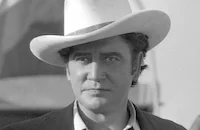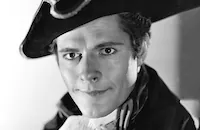Voice of the Whistler

Brief Synopsis
Cast & Crew
William Castle
Richard Dix
Lynn Merrick
Rhys Williams
James Cardwell
Tom Kennedy
Film Details
Technical Specs

Synopsis
At the Gull Point lighthouse, a woman lives all alone. Her strange story began years earlier with the rise to fortune and power of industrialist John Sinclair: Driven to a life of solitude by his distrust of his fellow man, Sinclair lives without love or companionship. One day, exhausted by his ruthless drive to attain wealth, Sinclair collapses and is ordered by his doctor to take a long rest. Deciding to take a cruise on the Great Lakes, Sinclair travels to Chicago and there collapses in a taxi driven by Ernie Sparrow. Sparrow, who is beloved for his kindness and consideration, takes Sinclair home and recalls a time when, as a famous boxer, he had no time for people or relationships. Sparrow declares that only by fleeing from fame and accepting the obscurity of life as a taxi driver did he find contentment and friendship. Sparrow insists that Sinclair, who has assumed the name John Carter, visit the local clinic, and there the doctor advises him to travel to New England for the healthful sea air. At the clinic, Sinclair meets nurse Joan Martin and her fiancé Fred Graham, a struggling intern. Believing that Sinclair has no money, Sparrow offers to buy him a ticket to New England, and out of gratitude, Sinclair invites Sparrow to accompany him at his expense. On the day of their departure, Sinclair reveals his true identity to Joan and proposes a business deal in which he will give her his entire fortune in return for her companionship during the few remaining months of his life. Weary of a life of poverty, Joan accepts his offer and asks Fred to wait for her. Unable to accept Joan's logic, Fred accuses her of being selfish and breaks off their relationship. In New England, Sinclair converts a lighthouse into a beach house, and as the months pass, he regains his health while Joan becomes lonely and restless and decides to leave him. Sinclair, who has fallen in love with Joan, offers to foresake the lighthouse and travel the world with her, and she agrees to give him another chance. Soon after, Fred visits the lighthouse and tells Joan that he has started his own practice and asks her to return to Chicago with him. Overhearing Joan reply that she needs time to make a decision, Sinclair invites Fred to stay with them. Sinclair, an accomplished chess player, describes a murder plot to Fred in which a murderer gets away with the crime by claiming that his victim fell out a window while sleepwalking. Fred takes Sinclair's bait, and decides to revise the plot to kill his rival. Feigning concern, Fred tells Sparrow about Sinclair's sleepwalking and asks him to buy locks for the windows. That night, Fred sneaks into Sinclair's bedrooom, planning to bludgeon him to death and then throw him from the window. Sinclair is waiting for Fred, however, and after knocking him unconscious, he drags his body to the window. Unable to open any of the windows, Sinclair carries Fred's body to the rocks where Sparrow sees him. When Sinclair explains that Fred fell out the window while sleepwalking, Sparrow replies that is impossible because he nailed all the windows shut. Sinclair then tells Sparrow the truth, and they return to the lighthouse and are greeted by Joan, who accuses Sinclair of murder and informs him that she has called the police. After Sinclair is electrocuted for his crime, Joan inherits his fortune. Haunted by tragedy, she is unable to escape her past and returns to the lighthouse to live out her life in desolation and torment.

Director

William Castle
Cast

Richard Dix

Lynn Merrick

Rhys Williams
James Cardwell

Tom Kennedy

Donald Woods
Egon Brecher

Gigi Perreau
Crew
M. R. Bakaleinikoff
Chris Beute
Dwight Caldwell
William Castle
Rudolph C. Flothow
Jack Goodrich
James M. Goss
Wilbur Hatch
George Meehan
Wilfrid H. Pettitt
Allan Rader

Film Details
Technical Specs

Articles
Voice of the Whistler -
Contrary to what one might assume, Dix did not play the title character in any of the seven Whistler pictures. In fact, no such character really exists, except as narrator and a kind of Greek chorus, commenting on the action and frequently taunting the characters from his omniscient perspective. The Whistler was voiced in all eight films by Otto Forrest, a bit player who later appeared in Sabrina (1954) and Around the World in 80 Days (1956). He was never given screen credit for any of the 13 pictures he made.
The series gave Dix an opportunity to play a wide variety of characters. In this one, he gets to play a ruthlessly driven wealthy industrialist who, on his doctor's orders to take a long rest, assumes a different identity and goes to live in a remote seaside spot in Maine with his nurse in tow. Revealing his true identity to her, he offers to leave her everything in her will if she will marry him and stay with him for what he believes are the final months of his life. Complications ensue when Dix falls for his beautiful caretaker, returning to health thanks to his new life, and devises a plan to murder her intern boyfriend, who expects to marry her after the rich man's death. As with most of the other tight little B pictures in the series, each running scarcely more than an hour, the mystery is less important. The end, after all, is revealed at the film's start. What audiences enjoyed were the clever plot twists by which the criminal is tripped up and the human drama played out by the characters.
Voice of the Whistler was directed by William Castle (1914-1977), later famous as the king of horror and exploitation in the 1950s and early 1960s. Castle began his directing career at the age of 18 with a stage production of Dracula and worked briefly in radio with Orson Welles. He directed his first short subject in 1939 and first feature in 1943. Columbia assigned him the initial film in this series, titled simply The Whistler (1944), and he would do four in all. The shock and horror movies he later produced and directed were known for their marketing gimmicks and his flamboyant presence, often making cameos in his movies and trailers a la Hitchcock. His most famous works include House on Haunted Hill (1959), The Tingler (1959), 13 Ghosts (1960), and several Grand Guignol suspense pictures with late-career stars like Joan Crawford (Strait-Jacket, 1964; I Saw What You Did, 1965) and Barbara Stanwyck and her ex-husband Robert Taylor (The Night Walker, 1964). John Goodman played a fictionalized version of Castle in Matinee (1993).
Fans of Hollywood's great character actors will no doubt recognize Rhys Williams, whose screen debut was as a coal miner in John Ford's How Green Was My Valley (1941), for which the Welsh-born actor also served as a language consultant. In addition to countless B movies, he appeared in such major productions as Mrs. Miniver (1942), The Spiral Staircase (1945), Johnny Guitar (1954), and Raintree County (1957). He made numerous TV appearances from the 50s through 1969, when he died at age 71. Here he plays the kindly ex-boxer who tries to help Dix find a new way of life.
If Dix saw any possibility for a career revival after leaving the Whistler series, he never got the chance to carry it out. He suffered a serious heart attack on board a cross-country train in September 1949 and died a week later at the age of 56. Unknown now to all but the most ardent classic film buffs, he was nominated for an Academy Award for his role in the western Cimarron (1931) and was remembered with a star on the Hollywood Walk of Fame in 1960.
The working title of the production was "Checkmate for Murder." While a couple of pictures in the series had titles that did not include the Whistler name, it was decided before release that this one would. As with all of them, however, it opens with the shadowy figure of the title character, who whistles a haunting tune and declares, "I am The Whistler, I know many strange tales." He "appears" at the end again to reveal the final outcome of the tale.
Director: William Castle
Producer: Rudolph C. Flothow
Screenplay: Wilfred H. Pettitt, William Castle; story by Allan Radar
Cinematography: George Meehan
Editing: Dwight Caldwell
Original Music: Mario Castelnuovo-Tedesco (uncredited)
Cast: Richard Dix (John Sinclair/John Carter), Lynn Merrick (Joan Martin Sinclair), Rhys Williams (Ernie Sparrow), James Cardwell (Fred Graham), Tom Kennedy (Ferdinand/Hammerlock)
By Rob Nixon

Voice of the Whistler -
Quotes
Trivia
Notes
The working title of this film was Checkmate for Murder. As in the other pictures in "The Whistler" series, this film opens with the shadowy figure of "The Whistler," who whistles a haunting tune and then declares, "I am The Whistler, I know many strange tales." The voice of The Whistler also closes the story, revealing the fate of the protagonist. For additional information on the series, please consult the Series Index and see the entry below for The Whistler.














